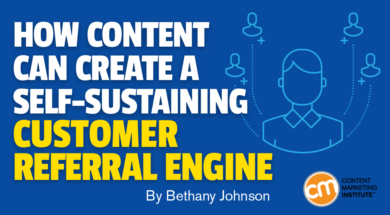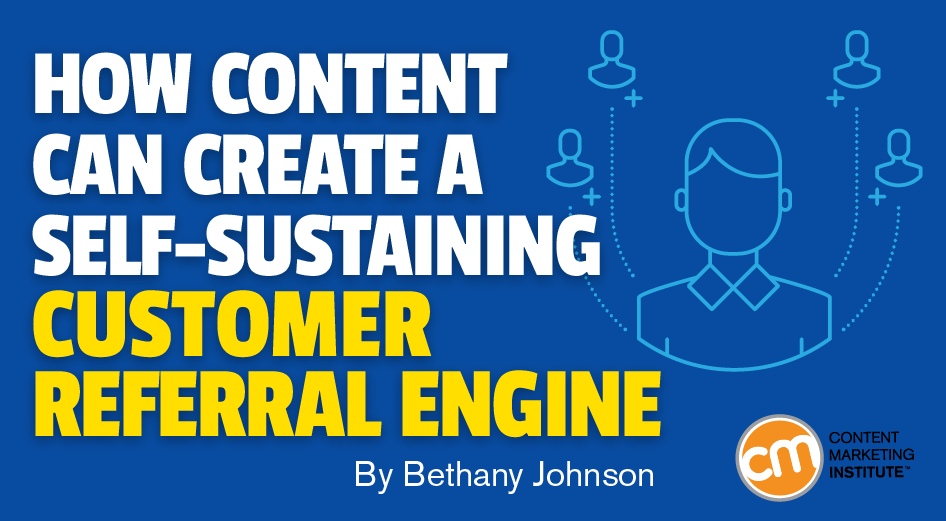
Robert Rose, CMI chief strategy advisor, loves to reset his audience’s brains with a truth bomb:
The purpose of a business is to create a customer.
This 60-year-old quote from management great Peter Drucker reminds marketers that their work – creating demand, generating traffic, prompting social shares, or even gathering leads — is in service of this one clear goal. It’s a refreshing pause button on all the distracting possibilities available.
Sulte Group CEO Teju Owoye takes the customer-creation concept one ambitious step further.
Your content can create a self-replicating referral engine, as Teju shares in her Content Marketing World presentation Accelerating Growth by Hacking Your Conversion Journey.
To get there, though, you first must help users learn to love the product or service they just signed up for.
Don’t stop building relationships at conversion
In the conventional sales and marketing funnel, marketing teams work on building awareness and nurturing prospects so some become leads and some eventually purchase a product or service. It’s tempting to celebrate those wins.
“It’s super exciting that you’ve got the customer to purchase your product, your service, engage with your platform,” Teju says.
But, what most marketers call “conversions” are truly a relatively minor transactional event that signals the start of a change. What happens next can determine who does the bulk of your future funnel-filling work — you or your happy customers.
“Marketers need to be intimately involved post-conversion to make sure that the customer is not only utilizing the product, but they become evangelists — and they’re referring their counterparts, their friends, their family, whoever is in their sphere of influence,” Teju says.
To boost growth, Teju suggests you guide the newly converted (through personalized content delivered at key moments) to become a different kind of customer – an active user who gets so much value from your product or service that the impulse to share it with others is almost irresistible.
Guide a new conversion to be a different kind of customer - an active user. @TejuOwoye. Read more>> Click To Tweet
Change how you view the buyer’s journey
What if, instead of applauding a conversion, a transaction, or a sale, you view a new subscriber or buyer as beginning the journey? What if you devoted the same measure of consideration and resources to new customers as to your red-hot leads? The traditional funnel changes to something more like this:

The right side is what Teju calls “our new job as marketers … making sure that the consumer has a delightful experience and is unlocking value at critical points while using your product.”
Get inside customers’ hearts and heads
To understand how best to guide your new customers toward this value, ask these familiar questions:
- What is it about our favorite product or service that make customers really love it?
- How does it make their lives easier?
- How does the brand respond when they have questions or problems?
- How does the product or service assimilate into or effect other aspects of their lives?
Then add a new, somewhat mind-bending question:
- Does their behavior change because of how they feel about the user experience? Or do their feelings change because of the new behavior once equipped with the product?
Good consumer sentiment prompts behavioral change. It’s no surprise that when customers feel a product or service can ease their pain, they engage with it. But did you know that the opposite is true?
Customer behavior can change how a customer feels. The more people act like power users, the more they feel like they are power users. The result is a magical, self-perpetuating brand advocate (a power user).
The more people act like power users, the more they feel they are power users. @TejuOwoye via @thanybethanybe. Click To Tweet(A note about “power users.” Although that term is often associated with software or apps, Teju is adamant that the concept works for any B2B or B2C company: “The same thing applies for a software as a service company, applies for a law office, or for a marketing agency: You want to make sure you have delighted customers who are referring you to people they know.”)
Use data to understand power users’ behavior
To bring the behavior-drives-feelings concept down to earth, Teju describes a client whose goal was to popularize its software — an app that powered a cash-back rewards program.
First, they dug deep into website tracking data to identify a handful of behavioral markers that distinguish their most active, engaged, happy customers — in other words, the super users.
Here’s what they found:
- Super users linked their credit cards to the mobile app right away. Immediately after signing up, they navigate their way to the “link-a-card” function, and they make it happen.
- Within the first seven days, super users visited about four restaurants, usually around lunch time on weekdays.
- Over the next couple weeks, they linked more credit cards — three on average.
The brand used the findings in a surprising way. Instead of going out to find new potential power users, Teju says, the team set out to create new power users within the existing subscriber base by developing a calendar of activation milestones.

Create content that changes existing users’ behavior
To support these milestones, the marketing team devised personalized messages for users who didn’t do these things, those who signed up without fully using the application’s features or getting the rewards. It started with a message like this:
“Glad to see you in our cash back rewards program. Next, link a card so you don’t miss out on any rewards.”
The goal of this message is to motivate an otherwise lukewarm customer to hit what Teju calls an “activation milestone.” In the expanded funnel, activation is the step that prompts people to really unlock the features of a product.
The marketing team did not expect an emotional investment in the program right away. That could come later. At this stage, a user’s actions mattered most.
Once a customer links some cards, the team sends a reminder like this:
“Looks like you haven’t tried using our app at a restaurant quite yet. Doing that separates our most well-rewarded ($$$!) app users from people who don’t get as much out of the experience.
“Tell you what. If you visit one of our affiliated venues in the next week, then we’ll sweeten your day by giving you a chance to win a restaurant gift card.”
The goal was to get this person to adopt the product or service and use it as a power user would. Incentives were a great way to achieve that goal – especially when your product rewards users organically in time.
Guide the aha moment
For example, this software company realized an aha moment would come for users who took enough power-user actions. A supremely gratifying moment would happen when the user would look down to find a fulfilling $10 reward on the app – just for continuing his usual spending habits.
Often, Teju says, the moment was so powerful the user remarked aloud to friends and family in casual conversation, creating a genuine word-of-mouth referral that sent new prospects right to the app.
The aha moment for power users is when they talk to friends about your product. @TejuOwoye. #wordofmouth Click To TweetGet this right, Teju says, and you’ve not just created a loyal customer, you’ve created a potential viral loop, the self-fueled engine of word-of-mouth marketing.
Much of today’s content endeavors to spark a feeling or perception. It’s tempting to try to convince consumers of their own desire for your solution – to make promises, brag, or otherwise compel audiences to a faux enthusiasm. When maybe, just maybe, another tactic could be to move them one step further toward power-user behavior.
The closer their behaviors inch them toward your product’s built-in rewards, the sooner they reach that natural aha moment. And that’s the kind of moment they can’t help but share with others.
Here’s an excerpt from Teju’s talk:
Want more pause buttons, truth bombs, and aha moments of your own? Register for Content Marketing World Sept. 4-7 in Cleveland, Ohio, and earn a $100 discount when you enter code BLOG100.
Cover image by Joseph Kalinowski/Content Marketing Institute

